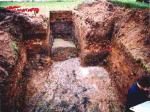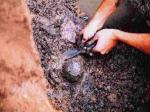Summary (English)
In 2006, rescue excavation (trial trenching) was carried out at the location of the Blatna Kupka in Topusko. Important archaeological finds that would testify to the use of nearby thermal water sources in the Roman and pre-Roman periods, which could be of inestimable value for the profession, but also for the tourist offer of Topusko, were expected here. A trial trench was opened at the endpoints of the new construction project, towards the administrative building of the sanatorium. The work lasted 5 working days, from September 14 to 20, 2006.
Underneath the thin layer of surface humus, there was a layer of crushed stone and loam. Underneath it, a slightly over half-meter thick layer, brown in colour, which was created as alluvium during the floods of the Glina River, was established. At an approximate depth of 150 to 200 centimetres, there is a black layer with a lot of organic material. A lot of fragments of Roman pottery were found in that layer. The concentration of finds was significantly higher than in the trenches opened the previous year. It can be concluded that the number of finds increases as the terrain approaches Nikolino brdo (Nikola’s hill), i.e. where the terrain is significantly less susceptible to floods. At depths greater than 2 meters, there is a grey layer, again with archaeological finds, but in noticeably smaller numbers. In addition, several pieces of wood were found in the mud. These could be the remains of wooden buildings that once stood in that place. The collected pottery fragments were washed, labelled and stored in the City Museum of Karlovac.
The goal of the excavation has been achieved. The levels of the cultural layers have been determined, and this greatly facilitates the further monitoring of the construction works and, within that, the archaeological watching brief. It was also established that at the construction site, there are no remains of structures which would make the construction at that location contested. However, the number of finds points to the obligation of careful monitoring of construction works and subsequently, initiation of the intervention in case archaeological finds are encountered (Lazo Čučković 2007, Hrvatski arheološki godišnjak 3/2006, 206–207).
- Lazo Čučković
Director
- Lazo Čučković
Team
Research Body
- GradskI muzej Karlovac






![Download [PDF]](/excavation/skins/fasti/images/results/download_sml.png)
